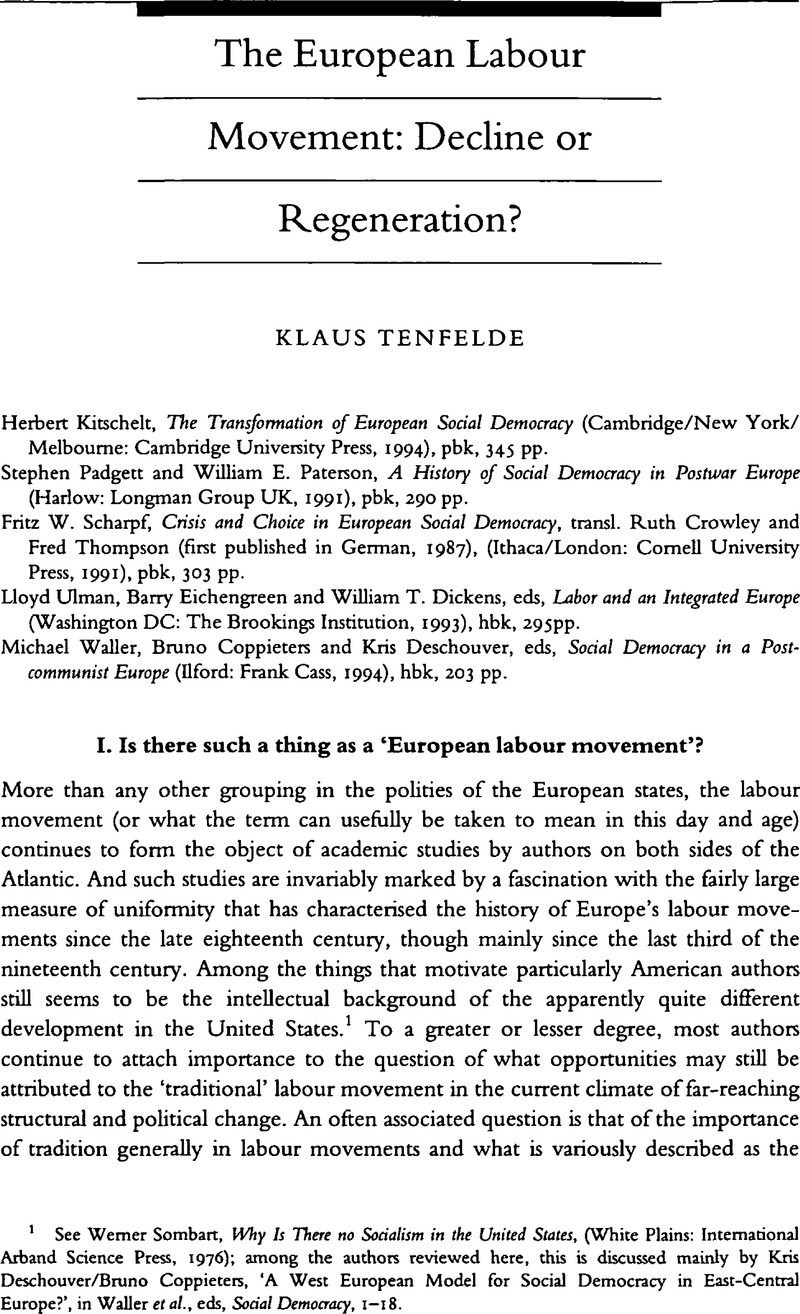No CrossRef data available.
Published online by Cambridge University Press: 12 September 2008

1 See Sombart, Wemer, Why Is There no Socialism in the United States, (White Plains: International Arband Science Press, 1976)CrossRefGoogle Scholar; among the authors reviewed here, this is discussed mainly by Kris Deschouver/Bruno Coppieters, ‘A West European Model for Social Democracy in East-Central Europe?’, in Waller, et al. , eds, Social Democracy, 1–18.Google Scholar
2 Even authors with such conflicting arguments as Padgett/Paterson and Kitschelt agree on this point.
3 Along with most authors I do not, in what follows, draw a line between, say, social democracies and socialisms or socialist parties.
4 Only a minor work by Lösche is cited: Die Neue Gesellschaft, (1988), 435 ff. Of central importance (together with the authors’ other, older works) is Lösche, Peter and Walter, Franz, Die SPD: Klassenpartei – Volkspartei – Quotenpartei. Zur Entwicklung der Sozialdemokratie von Weimar bis zur deutschen Vereinigung (Darmstadt: Wissenschaftliche Buchgemeinschaft, 1992).Google Scholar
5 On this point, the general opinion of research has recently been very sharply contradicted by Berger, Stefan, The British Labour Party and the German Social Democrats, 1900–1931 (Oxford: 1994)CrossRefGoogle Scholar, which likewise owes a debt to the concept of ‘solidarity communities’. See also his contribution on Germany in Berger, Stefan and Broughton, David, eds, The Force of Labour. The Western European Labour Movement and the Working Class in the Twentieth Century (Oxford/Washington DC: 1995), 71 ff.Google Scholar
6 Dahrendorf, Ralf, Life Chances: Approaches to Social and Political Theory (London: Weidenfeld and Nicolson, 1980); see alsoGoogle ScholarPadgett, and Paterson, , A History, 258.Google Scholar
7 With great respect for the achievements of their research, Kitschelt here emphatically disagrees with Przeworski, Adam and Prague, John, Paper Stones. A History of Electoral Socialism (Chicago: University of Chicago Press, 1986).Google Scholar
8 In the German edition (p. 307), the alternatives are Gipfelpfad and Ochsentour, implying a rather more starkly different ratio of speed to effort (‘fast track’ and ‘long haul’).
9 There are a few contributions in this connection concerning trade unions in individual countries, but in general social democracies receive a great deal of attention, while trade unions, even as regards international co-operation among them, receive very little, except for individual aspects (co-determination, corporatism, economic and social policy). As well as the Scharpf book reviewed here, see especially Gourevitch, Peter et al. ,, Unions and Economic Crisis: Britain, West Germany, and Sweden (London: Unwin and Allen, 1984)Google Scholar; Berger, Suzanne, ed., Organizing Interests in Western Europe: Pluralism, Corporatism, and the Transformation of Politics (Cambridge: Cambridge University Press, 1981).Google Scholar Compilations claiming to deal with European trade unions often contain only tacked-on national histories of trade unions. For social democracies, on the other hand, see for example Featherstone, K., Socialist Parties and European Integration: A Comparative History (Manchester: Manchester University Press, 1988).Google Scholar
10 Titmuss, Richard M., Social Policy. An Introduction (London: Allen and Unwin, 1974).Google Scholar